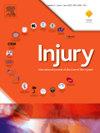Outcomes of surgically treated posterior pelvic fractures in an Australian population: A multicenter study
IF 2.2
3区 医学
Q3 CRITICAL CARE MEDICINE
Injury-International Journal of the Care of the Injured
Pub Date : 2025-01-20
DOI:10.1016/j.injury.2025.112169
引用次数: 0
Abstract
Background
Unstable posterior pelvic-ring fractures are rare and difficult to manage. There are many injury patterns, they are associated with high morbidity and mortality, and optimal surgical management remains contentions. This study aims to compare outcomes and complications for different surgical management of these injuries.
Methods
This was a multi-centre observational study of patients with traumatic posterior pelvic-ring injuries that underwent operative management between 1st January 2010 and 1st January 2020 at three Australian MTS. Cases were identified using internal hospital databases and the Victorian State Trauma registry. Data was retrieved from medical records and included surgeries, fixation method, length of stay, and outcomes (revision surgery, infection, hardware breakage, screw misplacement and hardware removal), time to each outcome was also recorded. The extracted data was collated and then analysed using RStudio; generalised liner models and linear regression models were developed to calculate mean differences and odd ratios.
Results
There were 439 cases (309 males and 130 females) in the cohort with a median age of 39 years. The overall prevalence of revision was 7.7 %; 4.8 % for infection, 1.8 % for hardware failure and 13.2 % for removal of hardware. Bulkier, more prominent fixation methods had higher rates of metalware removal. Numbers were too small in subgroups to detect a significant difference in complication rates between fixation method. However, bilateral injuries had a significant effect on revision with a calculated prevalence of 16.7 % vs 5.6 % for unilateral injuries. Cases managed with open-reduction had a calculated infection rate of 15.6 % vs 4.6 %. Length-of-stay was increased in patients managed with temporising external fixators, who had bilateral injuries, where infection occurred or were restricted to non-weight bearing postoperatively.
Conclusions
This study highlight bilateral posterior-pelvic ring injuries as a greater management challenge than unilateral injuries. It supports the use of percutaneous fixation with closed-reduction, decreased infection risk and decreased length-of-stay. It challenges the use of external fixators and supports less restrictive post-operative restrictions. This study also serves as a descriptive analysis for the current management of pelvic fractures in an Australian setting, shedding light on complication rates and profiles.
求助全文
约1分钟内获得全文
求助全文
来源期刊
CiteScore
4.00
自引率
8.00%
发文量
699
审稿时长
96 days
期刊介绍:
Injury was founded in 1969 and is an international journal dealing with all aspects of trauma care and accident surgery. Our primary aim is to facilitate the exchange of ideas, techniques and information among all members of the trauma team.

 求助内容:
求助内容: 应助结果提醒方式:
应助结果提醒方式:


